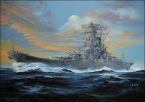Blackhorse
Posts: 1983
Joined: 8/20/2000
From: Eastern US
Status: offline

|
A few comments on the observations above:
1. Most modern tanks carry few true HE rounds. The most common anti-tank rounds are inert, except for the propellant. Most tanks also carry HEAT, which is designed to detonate after a distance, on impact, with the blast going directionally forward. So even if a grenade triggered a sympathic detonation, most of the blast effect would head down the barrel.
2. Depending on doctrine, tanks have been known to travel with a round in the tube. On exercises in West Germany in the mid-80s, practicing against a Warsaw Pact invasion of the Fulda Gap, US tanks might 'battle carry' sabot. The theory was, enemy tanks (or helicopters) were the main threat, and a round in the tube might enable you to engage first. If a lesser threat appeared first, we could fire off the sabot anyway, then load the most appropriate ammunition.
3. A thermite grenade down the tube would definitely hurt a tank. If it settled at the base of the tube, it would eventually fuse the barrel and breechblock. More effective than a fragmentation grenade, I think. But it would take some time.
4. Grenades were considered effective against tanks in WWII -- US infantry doctrine was to get a bundle or a bag of grenades and try to throw them against the side of an enemy tank to break the track, or blow off a roadwheel. Not for the faint of heart.
5. witpqs: interruptor screw, methinks.
_____________________________
WitP-AE -- US LCU & AI Stuff
Oddball: Why don't you knock it off with them negative waves? Why don't you dig how beautiful it is out here? Why don't you say something righteous and hopeful for a change?
Moriarty: Crap!
|
 Printable Version
Printable Version






















 New Messages
New Messages No New Messages
No New Messages Hot Topic w/ New Messages
Hot Topic w/ New Messages Hot Topic w/o New Messages
Hot Topic w/o New Messages Locked w/ New Messages
Locked w/ New Messages Locked w/o New Messages
Locked w/o New Messages Post New Thread
Post New Thread